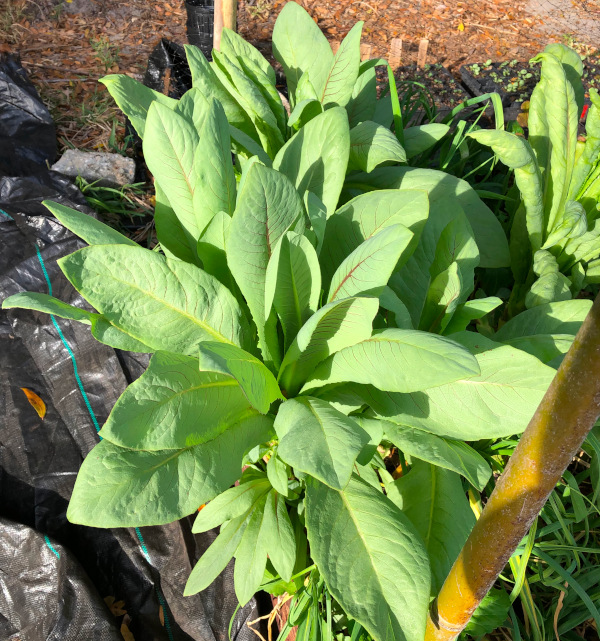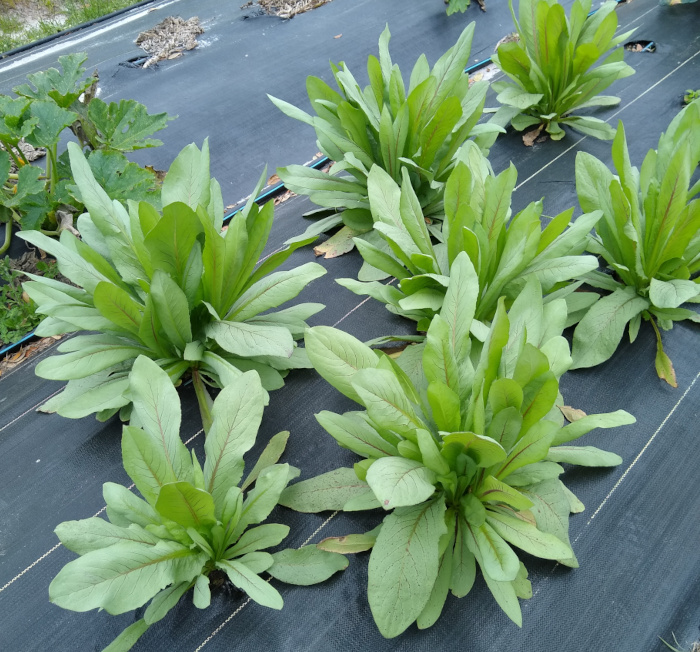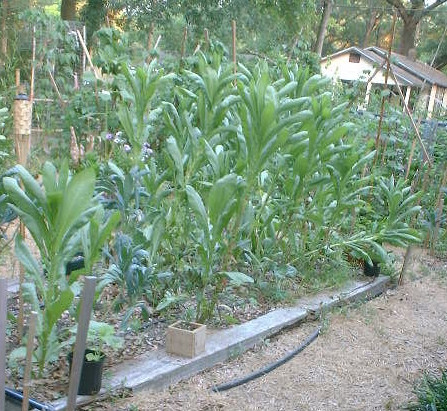
I recently distributed seeds of the tropical lettuce species Lactuca indica (sometimes called Indian lettuce), to a number of people. See my previous blog post for general info on the species. Because this plant has a few quirks, here are some tips for growing it.
If you are among the people who received seed, consider it as a rare, precious genetic resource, because it is. I am going to try to have seed available in the future, but there is no guarantee on that. That packet you got might be your one chance to grow this vegetable, and keep it going. Hopefully you will be able to grow the plants well enough that you can save your own seed maintain the species into the future.
Germinating the Seeds
I’ve found seed germination to be kind of erratic on Lactuca indica. Sometimes I’ve gotten near 100% germination, sometimes 5% or less. I’m not sure what accounts for the difference. It does seem that when I plant seeds immediately after harvesting them in fall, I tend to get good rates of germination. Sometimes older seed germinates well, sometimes not. So one thing I would recommend if you recently received seed: plant at least some of it immediately, if you are in Florida or a similar warm climate. In areas further north, you should probably wait till spring, unless you can provide a warm greenhouse environment all winter.
Also, I’ve found I’ve gotten best germination when I just sprinkle Lactuca indica seeds onto moist potting soil, and then barely cover them, or not even cover them at all. It may be that the seed needs light exposure to properly initiate germination.
(April 2023 Update: I’m now thinking the erratic germination I’ve experienced with this species is because the seeds need warm temps to germinate. That would explain why freshly harvested seed in September germinated so well – because temps are so warm here then. I will do more experimenting to confirm. But I recommend you give the seeds warm temps, 80F (27C) when germinating. If your temps are cooler than that, use a heating mat.)
Growing the Plants
Where I am in North Florida, when I plant seeds in fall, the plants grow all winter as a compact rosette of leaves. This species can handle frost. I’ve seen the plants come through overnight lows at least down to the mid-20s F, and they might be able to handle colder temps than that. Sometimes the leaf tips get burned after a freeze, but the bases of the leaves and the central core of the rosette are fine, and new leaves soon push out. So don’t worry about waiting till your area is frost-free before you start any seeds – these plants handle frosty North Florida winters and our steamy summers equally well.

In spring, those fall-sown Lactuca indica plants shift to an upright growth habit, and they continue getting taller and taller all summer, until they flower and set seed in August to September. You can also start seeds in spring or summer, and those plants seem to skip the low-growing rosette stage, and they start into upright growth right away. It seems that the ones started the previous fall are especially robust, turning into multi-stemmed, productive giants during the summer, sometimes eight feet tall or more. In South Florida, it may be that the warmer winter temperatures typical of the region mean that even fall-sown Lactuca indica plants will go immediately into an upright growth habit.
Whether the plants are in the low-growing rosette habit or are making upright growth, you can harvest leaves on a continual basis, taking a number of leaves every week from each plant. It may be that once the plants start growing upright, pinching out the tops will make them branch more, with greater leaf harvest (I haven’t experimented much with this).

The plants don’t seem to have any special requirements – they grow best and are most productive planted in good garden soil, with adequate nutrition and regular watering, although they can survive in much less ideal conditions. They can do well in full sun or partial shade. The leaves can have some bitter notes, especially in full sun and/or when drought stressed. I enjoy the bitter flavor elements, and I find Lactuca indica leaves are less bitter than some other vegetables like radicchio or Italian dandelion.
My overall assessment of the leaves as a vegetable is that they are a good tasting salad green, almost as good as common varieties of lettuce, but maybe a slight bit less flavorful and succulent. This makes sense, as lots of breeding work has gone into improving common lettuces, and I don’t know how much if any breeding has been done with tropical lettuce, at least the form of it that I have. So when common lettuces are in abundance during the cool season, I tend to eat them more than Lactuca indica. But as soon as they fade out in late spring, I happily switch over to tropical lettuce. It’s really the only green I know which grows well in summer in Florida and actually tastes good, even eaten in quantity. I hear people talk about using Talinum greens or Malabar spinach (Basella sp) for summer salads, and maybe that works for some – personally I don’t enjoy those raw in much quantity. But Lactuca indica leaves make a very nice base for a salad, in my opinion.
Saving Seed
I’ve seen some reports saying that Lactuca indica is perennial, but the form I have is strictly annual. In less than a year after germinating from seed, it flowers, puts all its energy into seed production, and the plant dies. In my area, tropical lettuce plants usually shift into reproductive mode at some point in late summer. I’m not sure if that’s triggered by day length, or just by the age of the plants – it would be interesting to do successive seedings over spring and summer to see. You’ll know the plants are shifting towards reproduction because they’ll start branching, and the leaves will get progressively smaller and skinnier. Eventually each branch will be tipped with a cluster of flowers.
Flowering of each cluster goes on for a few weeks, and then seed production is also an extended affair. I’ve found that each afternoon, another batch of seed heads open, exposing a little dandelion-like fluff ball of seeds attached to wind-catching fibers. The seeds are black and somewhat flattened. For maximum seed yield, you can try to be there every afternoon, catching that day’s seeds as soon as they open, before the wind sends them flying. That can be a lot of work to do that consistently every day, and you might want to content yourself with only harvesting a portion of that year’s seed production. You can also cut the whole head off once it starts releasing seed, but because seed production normally occurs over a period of weeks, some flowers within that bunch which are at an earlier stage of development might not be able to properly mature their seed once you sever the seed head from the plant. So again you’d have to content yourself with only a portion of the possible maximum seed harvest.
Sometimes tropical lettuce plants will self-sow in a garden, but not always. I suspect this might be one reason why people often lose this variety after a few years – they watch it reseed itself for several years, and they decide they don’t need to save seed because “it always comes back”. Until one year it doesn’t, and the person has no seeds saved. Make sure you save seed! Keep some saved in cool dry conditions, maybe in a tightly sealed jar in your refrigerator or freezer, as a fallback in case you ever lose the plants in your garden.
Potential
I think Lactuca indica is extremely useful right now in Florida and other warm climates as a home garden vegetable, and maybe also for small scale farm production. Beyond that, it has great potential for breeding lettuce varieties that are suited to large scale farm production, and which tolerate much higher levels of heat and humidity than varieties of common lettuce (Lactuca sativa). This will be increasingly important in future years as temperatures rise due to human-made climate change.
Definitely looking forward to giving this a try.
LikeLiked by 1 person
I think you are right, this plant has a lot of potential for a much warmer planet. I have done a quick search and don’t seem to be able to access seed in Australia though.
LikeLike
I try to pick the seed heads just before they open. The good ones are plump and you can detect a color change as they progress through maturation drying. Also, a bunch of white fibers are evident at the end, though they can also be evident well before this time, but differently. It’s hard to explain when I don’t have them in front of me to look at, but I remember there was a thing I noticed with the fibers also.
LikeLike
Thanks for a very thorough and comprehensive article of the Indian tropical lettuce.I live in sub tropical Queensland, Australia and have had the plant reseeding for the last 6 years. They do get to 8 ft .tall when flowering end of summer. I will try a prewinter crop from harvested previous years seed as The low rosette plants look very healthy.. The plants are sold in Asian market as Taiwanese lettuce. Definitely a great summer green I can’t do without. David Fam.
LikeLike